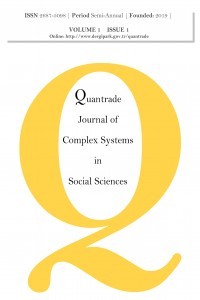The Effect of Organizational Change and Development Management on Sustainable Development
The Effect of Organizational Change and Development Management on Sustainable Development
___
- Aguinis, H., & Glavas, A. (2012). What we know and don’t know about corporate social responsibility: A review and research agenda. Journal of Management, 38(4), 932-968.
- Austin, M. (2008). Business development for the biotechnology and pharmaceutical industry. CRC Press. Beer, M., & Nohria, N. (2000). Cracking the code of change. Harvard Business Review, 78(3), 133-141.
- Bridges, W. (2017). Managing Transitions: Making the Most of Change. Da Capo Lifelong Books.
- Burke, W. W. (2014). Organizational Change: Perspectives on Theory and Practice. SAGE Publications.
- Cameron, E., & Green, M. (2019). Making sense of change management: A complete guide to the models, tools, and techniques of organizational change (5th ed.). Kogan Page Publishers.
- Carnall, C. A. (2007). Managing change in organizations. Pearson Education.
- Cummings, T. G., & Worley, C. G. (2014). Organization development and change. Cengage Learning.
- Dodgson, M., Gann, D. M., & Phillips, N. (Eds.). (2014). The Oxford Handbook of Innovation Management. Oxford University Press.
- Driffield, N., & Taylor, K. (2016). Globalization, Structural Change and the Labor Market. Routledge.
- Drucker, P. F. (2014). Innovation and Entrepreneurship: Practice and Principles. HarperCollins.
- Dunphy, D., Griffiths, A., & Benn, S. (2007). Organizational change for corporate sustainability: A guide for leaders and change agents of the future (2nd ed.). Routledge.
- Dyllick, T., & Muff, K. (2016). Clarifying the meaning of sustainable business: Introducing a typology from business-as-usual to true business sustainability. Organization & Environment, 29(2), 156-174.
- Eccles, R. G., & Serafeim, G. (2013). The performance frontier: Innovating for a sustainable strategy. Harvard Business Review, 91(5), 50-60.
- Elkington, J. (1997). Cannibals with forks: The triple bottom line of 21st-century business. Capstone Publishing.
- Epstein, M. J. (2008). Making sustainability work: Best practices in managing and measuring corporate social, environmental, and economic impacts. Berrett-Koehler Publishers.
- Esty, D. C., & Winston, A. S. (2009). Green to gold: How smart companies use environmental strategy to innovate, create value, and build competitive advantage. Yale University Press.
- Güven, B. (2021). In Organizational Management; White Collar Personnel Job Satisfaction and Organizational Performance Relationship . Quantrade Journal of Complex Systems in Social Sciences , 3 (1) , 1-11
- Harnish, V. (2014). Scaling up: How a few companies make it...and why the rest don't. Gazelles Inc.
- Holman, P., Devane, T., & Cady, S. H. (2007). The Change Handbook: The Definitive Resource on Today's Best Methods for Engaging Whole Systems. Berrett-Koehler Publishers.
- Kim, W. C., & Mauborgne, R. (2005). Blue ocean strategy: How to create uncontested market space and make the competition irrelevant. Harvard Business Review Press.
- Kogon, K., Blakemore, S., & Wood, J. (2015). Project management for the unofficial project manager: A FranklinCovey title. BenBella Books.
- Kotter, J. P. (1996). Leading change. Harvard Business Press.
- Kotter, J. P. (2012). Leading Change. Harvard Business Review Press.
- Lozano, R. (2015). A holistic perspective on corporate sustainability drivers. Corporate Social Responsibility and Environmental Management, 22(1), 32-44.
- Mullins, J. W. (2017). The new business road test: What entrepreneurs and executives should do before writing a business plan (5th ed.). Pearson.
- Osterwalder, A., & Pigneur, Y. (2010). Business model generation: A handbook for visionaries, game changers, and challengers. Wiley.
- Porter, M. E., & Kramer, M. R. (2011). Creating shared value. Harvard Business Review, 89(1-2), 62-77
- Pyka, A., & Cantner, U. (2016). The Economics of Structural Change in Knowledge. Routledge.
- Ries, E. (2011). The lean startup: How today's entrepreneurs use continuous innovation to create radically successful businesses. Crown Business.
- Savitz, A. W., & Weber, K. (2014). The triple bottom line: How today's best-run companies are achieving economic, social, and environmental success - and how you can too (2nd ed.). Jossey-Bass.
- Schaltegger, S., & Wagner, M. (Eds.). (2006). Managing the business case for sustainability: The integration of social, environmental, and economic performance. Greenleaf Publishing
- Senior, B., & Fleming, J. (2006). Organizational change. Pearson Education.
- Smith, W. K., & Lewis, M. W. (2011). Toward a theory of paradox: A dynamic equilibrium model of organizing. Academy of Management Review, 36(2), 381-403.
- Tushman, M. L., & O'Reilly III, C. A. (2007). Research and relevance: Implications of past research for future research in organizational change. Journal of Change Management, 7(3-4), 217-231.
- Ulusoy, T. & Civek, F. (2020). “İnsani İhtiyaçlar Değişiyor Mu? Maslow İhtiyaçlar Hiyerarşisinden Covid-19 İhtiyaçlar Hiyerarşisine Teorik Bir Değerlendirme” International Social Sciences Studies Journal, (e-ISSN:2587-1587) Vol:6, Issue:75;pp:5489-5495.
- Verzuh, E. (2015). The fast forward MBA in project management (5th ed.). Wiley.
- Willard, B. (2012). The new sustainability advantage: Seven business case benefits of a triple bottom line (10th anniversary ed.). New Society Publishers.
- Yayın Aralığı: Yılda 2 Sayı
- Başlangıç: 2019
- Yayıncı: Tolga ULUSOY
Strategic Planning In Libya's Higher Education System: A Theoretical Evaluation
Gri İlişkisel Analiz Yöntemiyle Türk Bankacılık Sektörünün İncelenmesi
The Effect of Organizational Change and Development Management on Sustainable Development
Paris Climate Agreement's Effect on Share Prices
Cryptocurrency Impacts on Strategic Management
Improving The Quality of Service In The Libyan Oil Sector: A Theoretical Assessment
Impact of using cryptocurrencies on monetary policy: A model of El Salvador
